Parkinson's Disease-related Antibodies
Phosphorylated α-Syn Antibody
| Phosphorylated α-Synuclein, Monoclonal Antibody | ||||||
| Cat. No. | Product Name | Grade | Package Size | |||
|---|---|---|---|---|---|---|
| 015-25191 | Anti Phosphorylated α-Synuclein, Monoclonal Antibody (pSyn#64) | For immunochemistry | 50 µL | |||
| Antibody Information | ||||||
| Antigen | α-Synuclein pS129 | Application | WB, IHC | Isotype | IgG | ■Immunostaining image Brain section of dementia with Lewy bodies 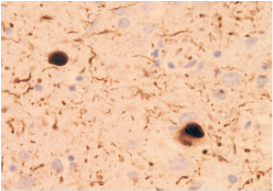 Courtesy of Iwatsubo,T., Graduate School of Medicine, The University of Tokyo |
| Antigen information | Amino acid residue 124-134 of human α-synuclein with phosphorylated serine at position 129 | Species cross reactivity | Human, Mouse, Rat | Label | Unlabeled | |
| Antigen synonyms | SNCA, PARK1, PARK4, NACP, PD1 | Host | Mouse | Clone No. | pSyn#64 | |
| Summary | Lewy body, a substance specifically found in nerve cells affected with Parkinson’s disease or dementia with Lewy body (DLB), contains α-synuclein protein of which serine at 129th position is specifically phosphorylated. This antibody does not react with normal α-synuclein, but recognizes only accumulated phosphorylated α-synuclein. This antibody is available for research in the Lewy body-related pathology. | |||||
| Reference | 1) Fujiwara. H., et al,.: Nature Cell Biology, 4, 160 (2002). 2) Saito. Y,.: Journal of Neuropathology and Experimental Neurology, 62, 644 (2003). |
|||||
| Biotin conjugated Phosphorylated α-Synuclein, Monoclonal Antibody | ||||||
| Cat. No. | Product Name | Grade | Package Size | |||
|---|---|---|---|---|---|---|
| 010-26481 | Anti Phosphorylated α-Synuclein, Monoclonal Antibody (pSyn#64), Biotin-conjugated | For immunochemistry | 100 µL | |||
| Antibody Information | ||||||
| Antigen | α-Synuclein pS129 | Application | IHC, ICC | Isotype | IgG | ■Immunostaining image Mouse brain section 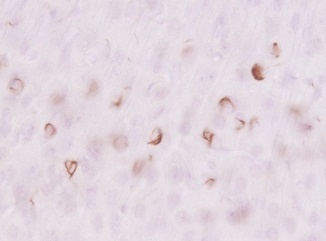 Courtesy of Kuwabara and Iwatsubo, Graduate School of Medicine, The University of Tokyo |
| Antigen information | Amino acid residue 124-134 of human α-synuclein with phosphorylated serine at position 129 | Species cross reactivity | Human, Mouse, Rat | Label | Biotin | |
| Antigen synonyms | SNCA, PARK1, PARK4, NACP, PD1 | Host | Mouse | Clone No. | pSyn#64 | |
| Summary | This is an biotin-conjugated antibody of above Anti Phosphorylated α-Synuclein, Monoclonal Antibody (pSyn#64) (Wako Cat. No. 015-25191). | |||||
Parkin Antibody
| Cat. No. | Product Name | Grade | Package Size | |||
|---|---|---|---|---|---|---|
| 010-27341 | Anti Parkin, Monoclonal Antibody (Par6) | For immunochemistry | 10 µL | |||
| 016-27343 | 50 µL | |||||
| Antibody Information | ||||||
| Antigen | Parkin | Application | WB | Isotype | IgG2·κ | ■WB image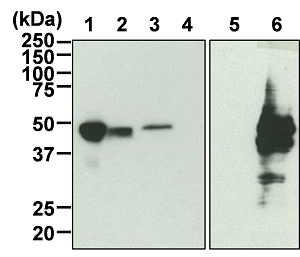
Lane1: Rat brain lysate
Lane2: Mouse brain lysate Lane3: PC12 cell Lane4: Hela cell Lane5: HEK293T cell Lane6: HEK293T cell express Human Parkin |
| Antigen information | Full length recombinant human Parkin | Species cross reactivity | Human, Mouse, Rat | Label | Unlabeled | |
| Antigen synonyms | PRKN, Parkin RBRE4 ubiquitin protein ligase | Host | Mouse | Clone No. | Par6 | |
| Summary | Parkin is an ubiquitin protein ligase about 50kDa that is a 465 amino acid with N-terminal ubiquitin-like domain. Parkin is a familial Parkinson disease (PD) gene product. PD is one of the most frequency neurodegenerative diseases. This item is a mouse monoclonal antibody which reacts with Parkin. | |||||
| Reference | - | |||||
Autophagy related Antibody
| Autophagy related Antibody, Atg7 | ||||||
| Cat. No. | Product Name | Grade | Package Size | |||
|---|---|---|---|---|---|---|
| 013-22831 | Anti Human Atg7, Rabbit | For immunochemistry | 50 µL | |||
| Antibody Information | ||||||
| Antigen | Atg7 | Application | WB | Isotype | IgG | ■WB Lysate of Mouse MEF 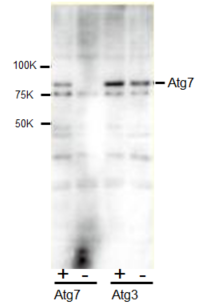 Courtesy of Ueno, T., Juntendo University School of Medicine |
| Antigen information | KLH-conjugated Human Atg7 aa 556-571 | Species cross reactivity | Human, Rat, Mouse | Label | Unlabeled | |
| Antigen synonyms | APG7L, GSA7 | Host | Rabbit | Clone No. | Polyclonal | |
| Summary | Atg7 is an essential factor to assemble autophagosomes during the process of autophagy. It is an E1-like enzyme that binds to ubiquitin-like proteins Atg8 and Atg12. Dysfunction of Autophagy factors have been reported in neurodegenerative diseases such as Parkinson’s disease. | |||||
| Reference | - | |||||
| Autophagy related Antibody, LC3 | ||||||
| Cat. No. | Product Name | Grade | Package Size | |||
|---|---|---|---|---|---|---|
| 010-22841 | Anti Rat LC3, Rabbit | For immunochemistry | 50 µL | |||
| Antibody Information | ||||||
| Antigen | LC3 | Application | WB, ICC | Isotype | IgG | ■Immunostaining image Hela cells 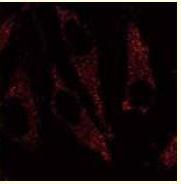 Courtesy of Kikkawa, M., Juntendo University Graduate School of Medicine |
| Antigen information | KLH conjugated LC3B aa 5-18 | Species cross reactivity | Human, Rat, Mouse | Label | Unlabeled | |
| Antigen synonyms | LC3B, MAP1LC3B, ATG8F, MAP1ALC3 | Host | Rabbit | Clone No. | Polyclonal | |
| Summary | LC3 is a mammalian analogue of Atg8 essential factor of autophagy in budding yeast. LC3 become LC3-I by removing C-terminal shortly after synthesis in cytoplasm. It is passed to E1-like enzyme (Atg7) and E2-like enzyme (Atg3) and it become LC3-II by binding with phospholipid. LC3-II bind to autophagosome membrane. This is why LC3 is used as a marker of autophagy. Dysfunction of autophagy factors have been reported in neurodegenerative diseases such as Parkinson’s disease. This antibody recognize both LC3-I and LC3-II. | |||||
| Reference | - | |||||
| Autophagy related Antibody, SQSTM1/A170/p62 | ||||||
| Cat. No. | Product Name | Grade | Package Size | |||
|---|---|---|---|---|---|---|
| 018-22141 | Anti SQSTM1/A170/p62, Rabbit | For immunochemistry | 100 µL | |||
| Antibody Information | ||||||
| Antigen | SQSTM1, A170, p62 | Application | WB, IHC, IF | Isotype | IgG | ■Immunostaining image Rat basal ganglion  Courtesy of Nakaso, K., Faculty of Medicine, Tottori University |
| Antigen information | Mouse SQSTM1/A170/p62 PEST domain (T7 tag + amino acid 254-333 + His tag) recombinant | Species cross reactivity | Rat, Mouse | Label | Unlabeled | |
| Antigen synonyms | Sequestosome 1, OSIL, PDB3, ZIP3, EBIA, PORCA, p62B | Host | Rabbit | Clone No. | Polyclonal | |
| Summary | Sequestosome 1(SQSTM1)/A170(Mouse )/p62(human)/ZIP (Rat) is a ubiquitin binding protein and shows oxidative stress-dependent expression. Recently, it is reported that SQSTM1 binds to LC3, an autophagy related factor. It attracts attention because it may induce protein degradation from ubiquitin/proteosome system to autophagy system. In neurodegenerative diseases including Parkinson’s disease, dysfunction of autophagy factor is implicated. | |||||
| Reference | Ishii, T., et al.: J. Biol. Chem., 275, 16023 (2000). | |||||
Product List
- Open All
- Close All
For research use or further manufacturing use only. Not for use in diagnostic procedures.
Product content may differ from the actual image due to minor specification changes etc.
If the revision of product standards and packaging standards has been made, there is a case where the actual product specifications and images are different.



